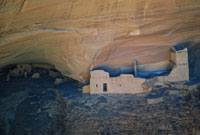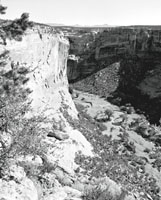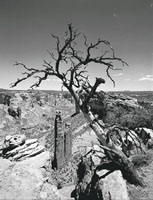|
 Bertha Dutton relates that in 1863 a band of 400 Mescalero Apache were
rounded up and taken to Bosque Redondo, where they were made to farm. They were there when the Navajo, under their leader Manuelito, were brought in.
At this time the Navajo and Apache were enemies and their co-presence didn't sit well with either side. The Navajo began to catch smallpox and die. The
water became tainted, so the Mescalero took what they could carry and fled in the night--men, women, and children. Word of conditions at Fort Sumner reached Washington two years later, and Carleton was relieved of his command
in 1866. Manuelito finally led his devastated people back to Canyon de Chelly and Canyon del Muerto. He lived to the age of 75 and died in 1894. Bertha Dutton relates that in 1863 a band of 400 Mescalero Apache were
rounded up and taken to Bosque Redondo, where they were made to farm. They were there when the Navajo, under their leader Manuelito, were brought in.
At this time the Navajo and Apache were enemies and their co-presence didn't sit well with either side. The Navajo began to catch smallpox and die. The
water became tainted, so the Mescalero took what they could carry and fled in the night--men, women, and children. Word of conditions at Fort Sumner reached Washington two years later, and Carleton was relieved of his command
in 1866. Manuelito finally led his devastated people back to Canyon de Chelly and Canyon del Muerto. He lived to the age of 75 and died in 1894.
Bobby said his grandfather, still alive and in his 90's, tells the stories that his father and mother told him about
surviving the Long Walk. Bobby told us about how Canyon de Chelly got its name, being a Spanish corruption of the Navajo word for canyon, tseye. He was telling us that Canyon del Muerto was from a Spanish word that had
something to do with dying, when a man who happened to be hiking down the trail at the same time interrupted to tell us that he speaks Spanish and 'Canyon del Muerto' means 'Canyon of Death'. Bobby showed no trace of
irritation but broke off the conversation and proceded down the trail. Later he told us he didn't want to embarrass the man by talking about how many Navajo the Spanish had killed in the 1805 massacre at Canyon del Muerto.
Bobby had a propensity for stopping in the sun and carrying on lengthy dialogues about some point of interest.
We were always looking for the nearest spot of shade but, being a native of the region, the hot sun didn't seem to
faze Bobby in the least, even while slogging through the stiflingly hot, dry, sandy creek bottom. Our first stop was
the White House ruin, which at first glance seemed smaller that we thought it would be. It is surrounded by a fence,
so you have to poke your lens through the fence to get a photograph. There were a lot of people there--tourists and Navajo selling jewelry and refreshments.
I would definitely recommend a wide angle lens. I envied O'Sullivan and Adams their opportunity to photograph
it before there were any restrictions on where you can go--and also before hordes of people arrived.
We hiked through groves of cottonwood, Russian olive, and tamarisk (salt cedar). These non-native trees were
planted in the upper canyon by the Park Service. Their seeds were washed down the canyons, and the trees are
now everywhere. Bobby said none of the trees were there when he was a kid. Most people agree that there is too
much Russian olive and tamarisk. But the shade, especially from the cottonwoods, was very pleasant and welcome. There are also two kinds of native willow, piņon, juniper, and oak trees scattered about the canyons.
 The hike had been all downhill to this point, but after we passed the White House Ruin we began to hike through
the bottom of Canyon de Chelly. The temperature rose into the 90's and no breeze stirred in the bottom of the canyon. The trees regularly gave way to expanses of loose
hot sand that made for difficult walking and the sheer rock walls of the canyon rose above us. We were able to photograph Ledge Ruin, but were unable to approach it
Even the Navajo do not have permission to enter the ruins, which are under the control of the National Park Service. But the Navajo have a long-standing aversion to ghosts,
so perhaps they aren't all that interested in entering the ruins anyway. The hike had been all downhill to this point, but after we passed the White House Ruin we began to hike through
the bottom of Canyon de Chelly. The temperature rose into the 90's and no breeze stirred in the bottom of the canyon. The trees regularly gave way to expanses of loose
hot sand that made for difficult walking and the sheer rock walls of the canyon rose above us. We were able to photograph Ledge Ruin, but were unable to approach it
Even the Navajo do not have permission to enter the ruins, which are under the control of the National Park Service. But the Navajo have a long-standing aversion to ghosts,
so perhaps they aren't all that interested in entering the ruins anyway.
We trudged on to Junction Ruin, where Chinle Wash splits into Canyon de Chelly
and Canyon del Muerto. It was tough going through all that sand, so what should have taken us 3 hours took almost 5. After climbing the 275 feet back out of the canyon, we
were thoroughly exhausted And after two nights in the tent, we were ready for a hot shower and a soft bed. We thought surely the motel in Chinle would be cheaper than
the Thunderbird Lodge in Canyon de Chelly, but as it turned out the difference was minimal and we wished we had stayed in the more pleasant environ of the Thunderbird. The Thunderbird charged $98 for a room for two, but a
first floor room at the Best Western in Chinle cost $105 (we took a second floor room for $89 plus $12 tax).
21 June 2000. Next morning we toured the north rim of Canyon del Muerto by car, stopping at most of the
overlooks for photographs. The views along the North Rim are spectacular. There were Navajo selling jewelry and other articles at almost every overlook. We noticed a heavy concentration of beer and wine bottles with assorted
beer cartons on the road along the north rim. Alcohol is outright illegal on the reservation, and the Navajo Tribal
Police can issue citations for possession. Many of the parking lots at the overlooks had signs stating that visitors
should lock their cars, as there has been a high incidence of break-ins in the vicinity. It seems that some of the Navajo kids are not above ripping off tourists now and then.
Tourists are forbidden to photograph Navajo people, animals, or dwellings without their consent. The same rule
applies on most North American Indian reservations, and protects the privacy of those who do not wish to be stared at or otherwise intruded upon.
 At our last two stops on the north rim of Canyon del Muerto Ed noticed a really beautiful little Native
American girl in traditional dress accompanied by an attractive Native American woman with her foot in a cast walking on crutches. He assumed they were Navajo
selling jewelry like everyone else. We were too tired from the morning hikes (and the day before) to do much on the south rim, but we both particularly wanted to
see Spider Rock which has special spiritual significance in the Navajo religion. At our last two stops on the north rim of Canyon del Muerto Ed noticed a really beautiful little Native
American girl in traditional dress accompanied by an attractive Native American woman with her foot in a cast walking on crutches. He assumed they were Navajo
selling jewelry like everyone else. We were too tired from the morning hikes (and the day before) to do much on the south rim, but we both particularly wanted to
see Spider Rock which has special spiritual significance in the Navajo religion.
When Ed got out to the very end of the Spider Rock overlook, where the view
was best, there was an old Native American gentleman sitting in the shade cradling a Nikon camera. Ed asked him if he had found the best place from which to
photograph Spider Rock, and he said it was right there. Ed decided he was right and set up his tripod. He and Ed struck up a conversation while Ed was making
his exposures. He asked about his Mamiya 7 camera, and Ed asked about his business. He said his name was Royal and he was there doing a calendar shoot.
His model should have been there a half-hour ago, but Royal didn't seem to be the least bit impatient--he was enjoying the view. We exchanged cards. His reads Royal SunCount Photography, 11034 E Montecito
Ave., Scottsdale, AZ 85256, phone (480) 970-3692. He also asked if Ed knew anything about digital cameras and Sybil showed him her Canon S20.
As Ed finished shooting, the young Native American girl with her escort on crutches arrived--she was his
model. Royal's color shot of the little girl in that sacred place of the Navajo should be a big hit.
|
|